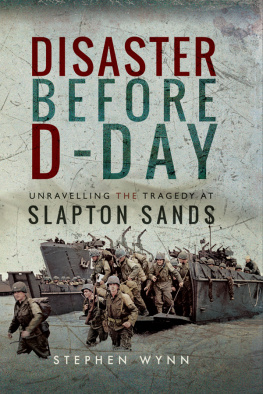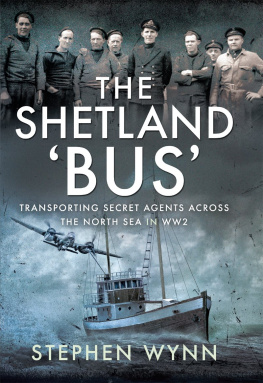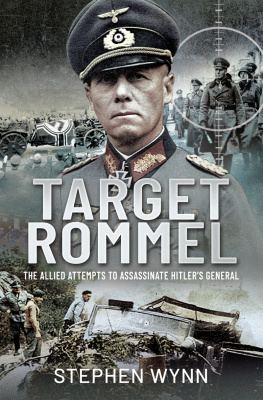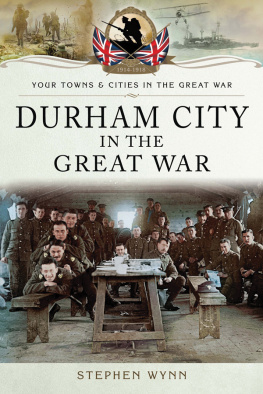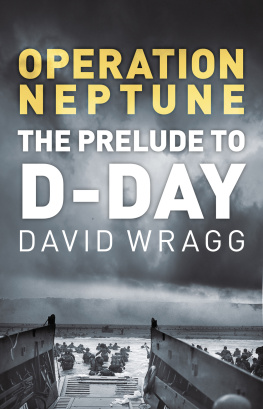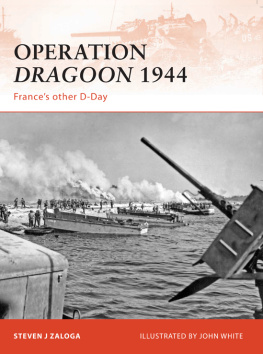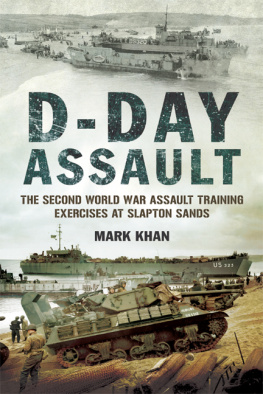Pagebreaks of the print version

Disaster before D-Day
Disaster before D-Day
Unravelling the Tragedy at Slapton Sands
by
Stephen Wynn

First published in Great Britain in 2019 by
Pen & Sword Military
An imprint of
Pen & Sword Books Ltd
YorkshirePhiladelphia
Copyright Stephen Wynn, 2019
ISBN 978 1 52673 511 9
eISBN 978 1 52673 512 6
mobiISBN 978 1 52673 513 3
The right of Stephen Wynn to be identified as Author of this work has been asserted by him in accordance with the Copyright, Designs and Patents Act 1988.
A CIP catalogue record for this book is available from the British Library.
All rights reserved. No part of this book may be reproduced or transmitted in any form or by any means, electronic or mechanical including photocopying, recording or by any information storage and retrieval system, without permission from the Publisher in writing.
Pen & Sword Books Ltd incorporates the Imprints of Pen & Sword Books Archaeology, Atlas, Aviation, Battleground, Discovery, Family History, History, Maritime, Military, Naval, Politics, Railways, Select, Transport, True Crime, Fiction, Frontline Books, Leo Cooper, Praetorian Press, Seaforth Publishing, Wharncliffe and White Owl.
For a complete list of Pen & Sword titles please contact
PEN & SWORD BOOKS LIMITED
47 Church Street, Barnsley, South Yorkshire, S70 2AS, England
E-mail:
Website: www.pen-and-sword.co.uk
or
PEN AND SWORD BOOKS
1950 Lawrence Rd, Havertown, PA 19083, USA
E-mail:
Website: www.penandswordbooks.com
Biography
S tephen is a happily retired police officer having served with Essex Police as a constable for thirty years, between 1983 and 2013. He is married to Tanya who is also his best friend.
Both his sons, Luke and Ross, were members of the armed forces, collectively serving five tours of Afghanistan between 2008 and 2013. Both were injured on their first tour. This led to Stephens first book, Two Sons in a Warzone Afghanistan: The True Story of a Fathers Conflict , which was published in October 2010.
Both of his grandfathers served in and survived the First World War, one with the Royal Irish Rifles, the other in the Mercantile Navy, while his father was a member of the Royal Army Ordinance Corp during the Second World War.
Stephen collaborated with one of his writing partners, Ken Porter, on a previous book published in August 2012, German PoW Camp 266 Langdon Hills , which spent six weeks as the number one best-selling book in Waterstones, Basildon between March and April 2013. Steve and Ken collaborated on a further four books in the Towns & Cities in the Great War series by Pen & Sword. Stephen has also written other titles in the same series of books, and in February 2017, The Surrender of Singapore Three Years of Hell 1942-45 , was published and Against All Odds Walter Tull The Black Lieutenant , followed in March 2018.
Stephen collaborated with one of his writing partners, Ken Porter, on a previous book published in August 2012, German PoW Camp 266 Langdon Hills , which spent six weeks as the number one best-selling book in Waterstones, Basildon between March and April 2013. Steve and Ken collaborated on a further four books in the Towns & Cities in the Great War series by Pen & Sword. Stephen has also written other titles in the same series of books, and in February 2017, The Surrender of Singapore Three Years of Hell 1942-45 , was published and Against All Odds Walter Tull The Black Lieutenant , followed in March 2018.
Stephen has also co-written three crime thrillers which were published between 2010 and 2012, and center round a fictional detective, named Terry Danvers.
When he is not writing, Tanya and he enjoy the simplicity of walking their four German Shepherd dogs early each morning when most sensible people are still fast asleep in their beds.
Chapter One
The 1938 military exercise at Slapton Sands
W hen Slapton Sands is mentioned in a historical sense, most people almost immediately connect it to the tragedy that occurred there and in the waters of Lyme Bay on 27 and 28 April 1944, when a large number of American soldiers and sailors lost their lives.
But there had been a previous military exercise at Slapton Sands in July 1938. This was mainly due to the insistence of Brigadier Bernard Montgomery who, despite British politicians trying to play down the relationship between Britain and Germany, foresaw the potential troubles ahead. Even earlier than that, in 1936, there had been an exercise at Swanage, as Nazi Germany began to flex its military muscles. Nobody wanted a war, except maybe Germany, but it had become a case of train for the worst while hoping for the best.
On Tuesday, 5 July 1938, as darkness fell across Slapton Sands, everything appeared to be normal on this stretch of the quiet Devon coastline, but in the early hours of Wednesday, its usual peace and tranquillity were suddenly broken as it became the scene of one of the biggest military exercises in the history of the nation, and certainly the biggest that had ever taken place in the West Country. It was a combined exercise which included the British Army, Navy and Air Force.
As the exercise got underway, military observers were watching keenly from inland vantage points.
There was a big difference between the exercises of 1938 and 1944 at Slapton Sands. The 1944 version was a practice for the invasion of German-occupied Europe on the beaches of Normandy, while the 1938 version was of a defensive nature, designed to deal with the threat of a German invasion of the UK mainland.
For the purposes of the exercise, the invading forces had selected Slapton Sands due to its long shingle beach where men and vehicles could be safely landed.
In the early hours of 6 July 1938, it looked like the planned exercise wasnt going to go ahead due to the inclement weather, but as the day progressed the weather improved, the wind dropped, and although there was a considerable swell further out in the English Channel, the waters of Start Bay were reasonably calm.
The exercise, which had first been spoken about a year earlier, had as its main objective the investigation of the tactical and technical aspects of an enemy amphibious landing, paying special attention to the potential seaward approach and attacking options having landed on the beach.
The pretend story and background to the exercise was thus: Wessex (Blueland), which is made up from the counties of Cornwall, Devon, Dorset, and Somerset, was being invaded by Eastland (Redland), which comprised what are often referred to collectively as the Home Counties: Berkshire, Buckinghamshire, Essex, Hertfordshire, Kent, Surrey, and Sussex. Also on their side was East Anglia, which included the counties of Norfolk, Suffolk, and parts of Cambridgeshire and Essex.
The presumption was that Eastland was much the stronger force and the chances of a successful landing and the subsequent occupation of a considerable area of land were more than just a probability.
The defenders of Wessex in the main consisted of the 2nd Battalion, Gloucestershire Regiment. Their platoons and sections were situated at a number of points a few miles inland at Higher Coltscombe, the road junction at Whitestone Cross, and the high ground which was just east of East Down. They only had machine guns and rifles at their disposal, with no artillery or tanks. This would be somewhat unrealistic and why such pieces of important equipment were missing wasnt explained. Maybe it was because they didnt want to damage any of the roads in the area that were most definitely not designed to cater for such heavy vehicles. Elements of the Territorial Army also took part in the exercise by occupying the Plymouth Fortress.

